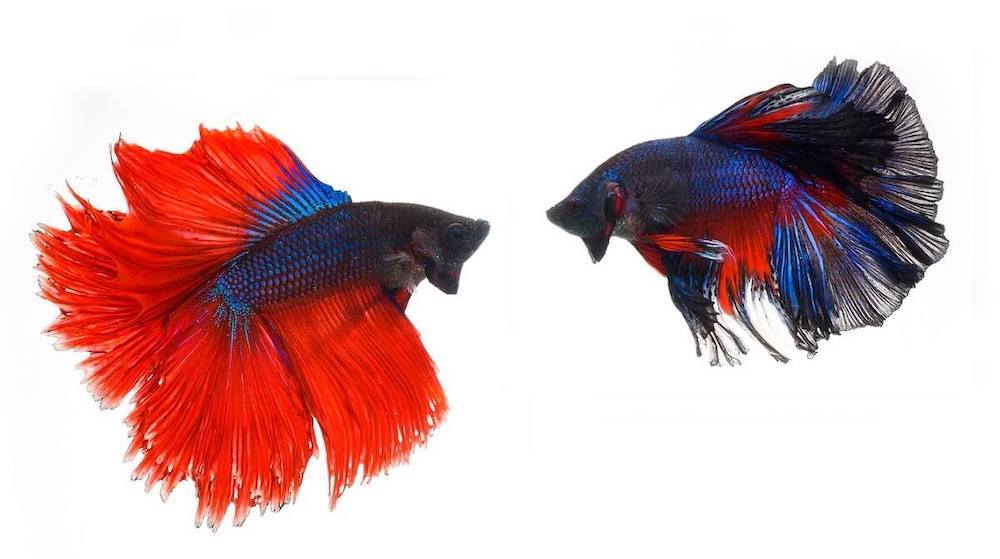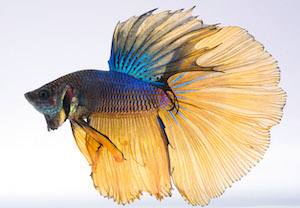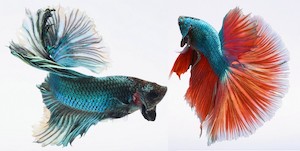
Betta fish, or also known as the Siamese Fighting Fish, is a member of the gourami family. They are native in the Mekong basin of Cambodia, Vietnam, and especially thriving in the water os the Chao praya river in Thailand. They are famous for their elegant and colorful looks because of their color and flaring fins placed on their elongated bodies. In contrast, it is their extremely aggressive and territorial behavior, which more often than likely result in a dead fish in the tank. Betta fish can live up to five years in captivity.
Their colors make them especially attractive to fish keepers with their flaring fins and brilliant colors ranging from blue, green, orange, red, violet to silver color schemes. Their color is also indicative of their moods. They would display a deeper shade when agitated and when they are starting to mate, colors and patterns would appear to signal their mates.
Why Do Betta Fish Fight?

Taking care of betta fish is challenging since they would often fight other fish with marking their spot. They are observing the difference betta fish in tanks and the wild; betta fish exhibit a higher level of aggression in captivity due to the fact of limited space. In the wild, they are less likely to fight for territory due to the broader swimming space. Betta fish often live in environments with limited food resources, resulting in their tendency to protect their places from other fishes.
Male betta fish are more aggressive than the female counterparts. Male bettas often choose their territory that is surrounded by rocks or plants. Once a fish, even of their kind, happens to trespass, they would fight until one gets injured, backs out, or dies. Their territories are especially important to them to obtain a mate. Their territory is one of the most important factors they have in getting a chance to attract a female and breed, and if a competitor appears, this will potentially dwindle their chance of breeding.
Another thing that causes tumult among your betta fish is stress. As a fishkeeper, you need to be sensitive when it comes to changes in water temperature, climate, and conditions since this can easily stress a betta fish. Even changing your aquarium decorations make betta fish antsy since they see it as a marker of the territory they have established. Also, male betta fish is protective and become aggressive once they have perceived that their bubble nests are in danger or even bothered.
Both male and female bettas are better kept apart, except for taking them in together temporarily when mating. It is because if they are put together in a tank, this will often result in fights for territory.
Females and males are only pair together when breeding. During the breeding stage, the male would create a bubble nest at the surface of the tank. When the male is interested in the female, he will signal the female to get closer by expanding his gills, fins, and twisting its body in a sort of dance. As they spawn, the female will drop eggs, and he’ll chase the female to prevent her from eating the eggs. Once it drops its eggs, it should be immediately moved back to its aquarium. The males serve as protectors of the spawnlings, ensuring that these have a chance of surviving and hatching. If a fish keeper happens to leave the female betta fish with the male, there is a high chance of the male going after the female and end up killing her.
Female betta fish display the same aggression as males though for different reasons. They are less territorial than males, and until establishing a hierarchy, females’ aggressiveness can observe. Among female groups or sororities, there would be 4 to 5 female bettas, and once set up the social order, this will pretty much make the females more at peace. If not, then the particular fish should be isolated for the time being.
Another fact is that the Siamese fighting fish is the result of centuries worth of stage battle breeding by the people from Southeast Asia, making this particular fish especially aggressive. Siamese fighting fish fighting is infamous for this, similar to cockfights, which will place the wagers of the fight. This culture still lives on until today.
Choosing suitable tank mates is also a must for betta fish. In particular, avoid pairing them with fishes that have large tails and long fins. They would be more accepting of Corydora catfish, clown plecos, Neon tetras, Harlequin rasboras, and Kuhli loaches.
How Do Betta Fish Fight?

What are the telltale signs that a betta fish is about to take on a fight?
At first, betta fish would try to intimidate trespassers and scare them away buy puffing itself up with their gills, fins, and tail trying to appear much bigger than actual. If the other fish doesn’t back off, it would display its aggressive tendencies and fight by biting the other fish’s fins until one of them retreats or will likely result in death.
Fights between betta fish may be quite short to a couple of minutes. Though, yes, their aggressive nature is a result of inbreeding that some still carry this trait and most likely hurt their tank mates and especially against other betta fishes. At the most, fights can last up to an hour, which can be cruel, aggravating their physical state from the constant nipping of fins, tails, scales, and gills. The fight may end with a dead fish, but the infection that will fester from the wounds, stress, and trauma are also weighty factors for killing the betta fish in the aftermath.
How To Prevent Betta Fish From Fighting?
Betta fish make a beautiful addition to your aquarium and are moderately challenging to take care of, and the particular challenge in taking care of them is their aggressive, territorial nature. So, here’s a list of tips to prevent your bettas from fighting and have a peaceful experience in your tank.
- Keep only one male betta fish in your tank. It will lower the risk of betta fish fighting, and he will have to adjust to the hierarchy that is already established by its tank mates, whether they have bright colors, long fins, and large tails.
- Make sure you have a big tank. If you are going to purchase betta fish, your aquarium should hold at least 25 gallons to provide swimming space and avoid clashing with other fishes’ paths.
- Add plenty of designs to your tank. It will provide plenty of hiding spots like plants (plastic or real), rocks, corals, and makeshift shelters. Beneficial to pretty much every fish in the tank since this will make them feel safe and distracting them by having so many more obstacles to get around. It will also create an effective partition of territories resulting in lowered stress levels.
- Do not underestimate tank mate compatibility. Researching will help you provide the right companion to your betta fish, suiting to their temperament while adding variety to your tank.
- Immediately resolve a potential conflict by either isolating the fish to another tank or dividing the tank with a partition.
CONCLUSION
Betta fish has had a long history of aggressiveness, though, despite this, fishkeepers have long since been fascinated with their vibrance and beauty, as well as the pride of raising this type of fish. As a territorial fish, their aggressiveness is quite understandable for their survival in aspects of mating, breeding, and food.
Betta fish are quite intelligent and can be honed through conditioning to tone down their aggressive streaks. If you are new to the experience in raising and taking care of Siamese Fighting Fish, expect that fights will most likely entail, especially towards other fish and even towards its kind. However, with the help of the tips and guidelines above, such as having an ample tank space, plenty of hiding spots, and designs, as well as tankmate compatibility, chances of fights will decrease.
With proper maintenance such as water conditions and food, betta fish is a delight to keep—an incredible attraction to your tank.








